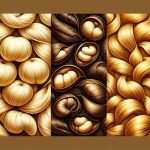I'll share about the 4 main silk types. Mulberry silk, the most common, has smooth fibers and a white shade. Eri silk, with a wool-like feel, originates from caterpillars in Asia. Muga silk from Assam gleams in a unique gold hue. Finally, Tussar silk, with a golden tint, comes from wild Indian forests. There's a lot more to discover about these fascinating silk varieties.
Table of Contents
Key Takeaways
- Mulberry Silk is renowned for its quality and long, smooth fibers.
- Eri Silk offers a wool-like texture and thermal properties, popular for blending.
- Muga Silk produces a unique golden hue from silkworms feeding on soalu plants.
- Tussar Silk stands out for its natural golden hue and textured appearance.
- Each type of silk, whether Mulberry, Eri, Muga, or Tussar, has distinct characteristics and uses.
Mulberry Silk
Mulberry silk, the most common type of silk globally, is renowned for its exquisite quality and versatility. This luxurious silk is produced by the silkworm Bombyx mori, which exclusively feeds on mulberry leaves to create its cocoon. What sets Mulberry silk apart is its long, smooth fibers and distinctive pearl white color, making it highly sought after in the world of textiles. The quality of Mulberry silk can be determined by the momme count, with higher counts indicating denser and superior silk fabric.
When it comes to silk production, Mulberry silk plays a dominant role, accounting for approximately 90% of global silk output. Its fine quality and durability make it a popular choice for a wide range of applications, including clothing, bedding, and various luxurious textiles. Whether you're looking for a soft and lustrous fabric for your wardrobe or seeking comfort in your bedding, Mulberry silk stands out for its exceptional quality and versatility in diverse silk products.
Eri Silk
Eri silk, sourced from caterpillars native to North East India, China, and Japan, offers a unique blend of wool-like texture and thermal properties. This type of silk, derived from the Samia Cynthia caterpillars, stands out for its distinctive qualities when compared to other silks.
Its wool-like feel and excellent thermal insulation make it a popular choice for blending with other materials, such as in curtains, bed covers, and silk-blend fabrics. Despite being less opulent and textured than some silk varieties, Eri silk's ability to provide warmth while remaining lightweight sets it apart.
The white color of Eri silk, coupled with its soft, cotton-like texture, lends itself well to a variety of applications. Its versatility and practicality in creating cozy yet breathable fabrics make it a sought-after option for those looking for a unique silk experience that prioritizes functionality alongside comfort.
Muga Silk
Producing a radiant, golden hue, Muga silk is exclusively crafted in the picturesque Assam region of India. This glossy, high sheen fabric is renowned for its lustrous appearance and unique golden color, making it a luxurious and exclusive choice.
Muga silk gets its exceptional qualities from silkworms that feed on soalu plants, a process that results in the prized golden silk highly valued for its stunning beauty and superior quality. The Assam region's climatic conditions and the expertise of local artisans contribute to the exceptional nature of Muga silk, with its shimmering texture and rich color that sets it apart in the world of textiles.
The intricate craftsmanship involved in producing Muga silk reflects the cultural heritage and traditional skills of the Assamese people, adding to the allure and desirability of this exquisite silk variety.
Tussar Silk
Crafted in the wild forests of India, Tussar silk stands out for its natural golden hue, setting it apart from other varieties of silk. This silk, harvested from silkworms, has a more textured appearance compared to the smooth Mulberry silk. While Tussar silk is less durable than Mulberry silk, it remains a popular choice for garments like sarees due to its unique characteristics.
One distinct feature of Tussar silk is the rustling sound it makes. The creases in the fabric create this characteristic noise, adding to its allure. This audible quality sets Tussar silk apart, giving it a tactile and auditory appeal that enhances its beauty.
Despite being less durable, the rich color and textured appearance of Tussar silk make it a sought-after material in the world of textiles. Its connection to the wild forests of India and the distinctive rustling sound it produces contribute to the charm and uniqueness of this type of silk.
Frequently Asked Questions
What Is the Highest Quality Silk?
The highest quality silk is Grade A, known for its long strands and pearl white color. It's breathable, smooth, and lightweight, perfect for luxurious products. Grade A silk is categorized into 6 varieties, with 6A being the top tier in quality and purity.
What Is the Softest Silk in the World?
The softest silk in the world is Mulberry silk, cherished for its delicate feel and natural sheen. It's produced by Bombyx mori silkworms and its high momme count signifies quality. I love its luxurious comfort.
What Are 5 Fabrics Made of Silk?
Silk fabrics like charmeuse, chiffon, crêpe-de-chine, dupion silk, and georgette offer diverse textures and finishes. They cater to various garment needs, from delicate lingerie to elegant evening wear. Each type brings its unique touch to the fashion world.
What Is Non Shiny Silk Called?
Non-shiny silk, like Matka silk, has a textured look and a matte finish. It's great for casual or rustic outfits. The unique earthy vibe of Matka silk adds elegance to suits, jackets, and ethnic wear, making them stand out.
- How to Clean and Care for Your Herringbone Fabric Sofa - June 19, 2025
- The History of Herringbone Fabric: From Ancient Rome to Modern Fashion - June 19, 2025
- Exploring Herringbone Cotton Twill: A Durable & Versatile Fabric Choice - June 19, 2025






